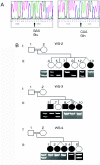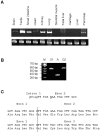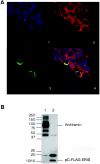A homozygous mutation in a novel zinc-finger protein, ERIS, is responsible for Wolfram syndrome 2
- PMID: 17846994
- PMCID: PMC2227919
- DOI: 10.1086/520961
A homozygous mutation in a novel zinc-finger protein, ERIS, is responsible for Wolfram syndrome 2
Abstract
A single missense mutation was identified in a novel, highly conserved zinc-finger gene, ZCD2, in three consanguineous families of Jordanian descent with Wolfram syndrome (WFS). It had been shown that these families did not have mutations in the WFS1 gene (WFS1) but were mapped to the WFS2 locus at 4q22-25. A G-->C transversion at nucleotide 109 predicts an amino acid change from glutamic acid to glutamine (E37Q). Although the amino acid is conserved and the mutation is nonsynonymous, the pathogenesis for the disorder is because the mutation also causes aberrant splicing. The mutation was found to disrupt messenger RNA splicing by eliminating exon 2, and it results in the introduction of a premature stop codon. Mutations in WFS1 have also been found to cause low-frequency nonsyndromic hearing loss, progressive hearing loss, and isolated optic atrophy associated with hearing loss. Screening of 377 probands with hearing loss did not identify mutations in the WFS2 gene. The WFS1-encoded protein, Wolframin, is known to localize to the endoplasmic reticulum and plays a role in calcium homeostasis. The ZCD2-encoded protein, ERIS (endoplasmic reticulum intermembrane small protein), is also shown to localize to the endoplasmic reticulum but does not interact directly with Wolframin. Lymphoblastoid cells from affected individuals show a significantly greater rise in intracellular calcium when stimulated with thapsigargin, compared with controls, although no difference was observed in resting concentrations of intracellular calcium.
Figures





References
Web Resources
-
- Allen Brain Atlas, http://www.brain-map.org/welcome.do
-
- Human Protein Reference Database, http://www.hprd.org/ (for accession number 17413)
-
- Online Mendelian Inheritance in Man (OMIM), http://www.ncbi.nlm.nih.gov/Omim/ (for WFS, WFS2, and Wolcott-Rallison syndrome)
References
-
- Wolfram DJ, Wagener HP (1938) Diabetes mellitus and simple optic atrophy among siblings: report of four cases. Mayo Clin Proc 13:715–718
-
- Cremers CWRJ, Wijdeveld PGAB, Pinckers AJLG (1977) Juvenile diabetes mellitus, optic atrophy, hearing loss, diabetes insipidus, atonia of the urinary tract and bladder, and other abnormalities (Wolfram syndrome): a review of 88 cases from the literature with personal observations on 3 new patients. Acta Paediatr Scand Suppl 264:1–16 - PubMed
-
- Inoue H, Tanizawa Y, Wasson J, Behn P, Kalidas K, Bernal-Mizrachi B, Mueckler M, Marshall H, Donis-Keller H, Crock P, et al (1998) A gene encoding a transmembrane protein is mutated in patients with diabetes mellitus and optic atrophy (Wolfram syndrome). Nat Genet 20:143–14810.1038/2441 - DOI - PubMed
Publication types
MeSH terms
Substances
Grants and funding
LinkOut - more resources
Full Text Sources
Other Literature Sources
Medical
Molecular Biology Databases
Research Materials

